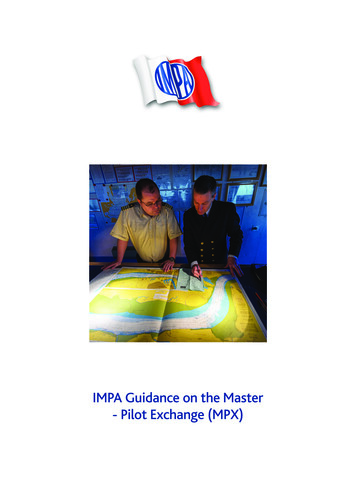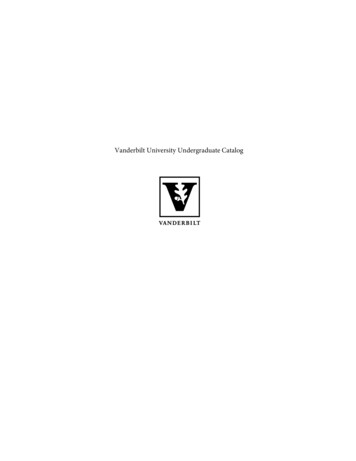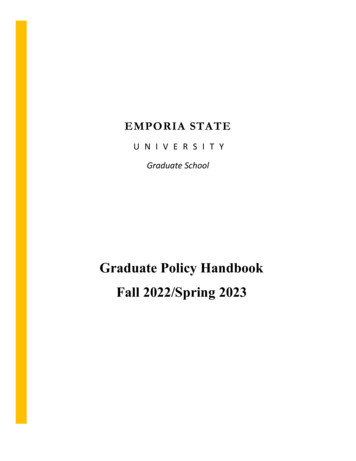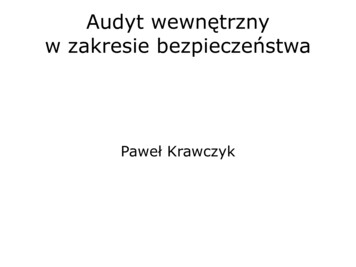
Transcription
IMPA Guidance on the Master- Pilot Exchange (MPX)
IntroductionEach Pilotage assignment should begin with an exchange ofinformation between the master and the pilot. This exchange is aprelude to a successful passage under pilotage and is a key componentof effective BRM during the passage.I M PA G u i d a n c e o n t h e M a s t e r - P i l o t E x c h a n ge ( M P X )
As with all properly constructed supporting text on pilotage, it is necessaryto begin with the core foundation of IMO Resolution A960 (23) Section 5: -5. Master – pilot information exchange5.1 The master and the pilot should exchange informationregarding navigational procedures, local conditions and rulesand the ship’s characteristics. This information exchangeshould be a continuous process that generally continues forthe duration of the pilotage.5.2 Each pilotage assignment should begin with an informationexchange between the pilot and the master. The amount andsubject matter of the information to be exchanged should bedetermined by the specific navigation demands of the pilotageoperation. Additional information can be exchanged as theoperation proceeds.5.3 Each competent pilotage authority should develop astandard exchange of information practice, taking into accountregulatory requirements and best practice in the pilotage area.Pilots should consider using an information card, form, checklistor other memory aid to ensure that essential exchange itemsare covered. If an information card or standard forms is usedby pilots locally regarding the anticipated passage, the layoutof such a card or form should supplement and assist, notsubstitute for, the verbal information exchange.2. general agreement on plans and procedures, includingcontingency plans, for the anticipated passage;3. discussion of any special conditions such as weather,depth of water, tidal currents and marine traffic that maybe expected during the passage;4. discussion of any unusual ship-handling characteristics,machinery difficulties, navigational equipment problems orcrew limitations that could affect the operation, handlingor safe manoeuvring of the ship;5. information on berthing arrangements; use, characteristicsand number of tugs; mooring boats and other externalfacilities;6. information on mooring arrangements; and7. confirmation of the language to be used on the bridgeand with external parties.5.5 It should be clearly understood that any passage plan isa basic indication of preferred intention and both the pilotand the master should be prepared to depart from it whencircumstances so dictate.5.4 This exchange of information should include at least:1. presentation of a completed standard Pilot Card. Inaddition, information should be provided on rate of turn atdifferent speeds, turning circles, stopping distances and, ifavailable, other appropriate data;5.6 Pilots and competent pilotage authorities should beaware of the voyage planning responsibilities of masters underapplicable IMO instruments.I M PA G u i d a n c e o n t h e M a s t e r - P i l o t E x c h a n ge ( M P X )
FURTHER GUIDANCEThe following is offered by IMPA as guidance for the developmentof practices for the exchange of information between themaster and the pilot regarding navigational procedures, localconditions and rules, and the ship’s characteristics.When presented by the master and crew with a Pilot Cardor other document containing the characteristics oroperational conditions of the ship, pilots should keep inmind that they are under no obligation to sign or initialsuch documents and that a signature or initial could beconstrued as a form of confirmation that the informationon the document is accurate.Initial conferencePilot Information Card (“MPX Card”) The initial conference is an opportunity not only toexchange information that the pilot and master eachneed, but also for the pilot and the master to establishan appropriate working relationship that will continuethroughout the pilotage assignment. The amount and nature of the information to be exchangedin the initial conference should be determined by thespecific navigation demands of the pilotage assignment.This information should typically include: Pilots and pilot groups should consider developing aninformation card (“MPX Card”) to give to the master atthe time of the initial conference and be used as a guidefor discussion during the conference and the subsequentpilotage assignment. The MPX Card should include information specific to navigationin the local pilotage area as well as the instructions or requestconcerning the pilot’s needs from the master and crew.As stated in A960, the MPX Card should supplement, notsubstitute for, the verbal information exchange.the ships ‘s navigational characteristics and numbers oftugs to be used, as appropriate; and the language to beused on the bridge and with external parties. Absent or unwilling masterFor some assignments, particularly those involving along run or difficult manoeuvres at the beginning, not allrelevant information must, or should, be exchanged in theinitial conference. Additional information can be exchangedas the assignment proceeds and communication shouldbe understood as a continuous process that generallycontinues for the duration of the assignment.Ship’s Pilot Card/Wheelhouse Poster Pilots should be aware of regulations requiring ships tohave a “Pilots Card” and wheelhouse poster containingmanoeuvring data and other information concerning theship. If the pilot, in the exercise of his or her best judgment,considers the information provided orally by the masterabout the ship and its characteristics unclear or insufficient,the pilot should consult the Pilot Card/wheelhouse posterto confirm or supplement the information from the master. Pilots should be aware that information on Pilot card/wheelhouse poster about a ship’s propulsion, manoeuvringand handling characteristics may not be accurate whenmanoeuvring in the particular waters of the pilot’s areaor under local conditions that may be present during thepilotage operation. Such information must be based on“new vessel” conditions (which may be affected by factorsuch as bottom fouling, propeller/rudder damage, or trim)and operation in the open sea. An effective exchange requires the participation of amaster who is present, is willing, and has sufficient skills,knowledge, and language proficiency to provide theinformation needed by the pilot and to understand thepilot’s instructions and requests. The pilot should make all reasonable efforts to obtain thepresence of the master for the purpose of conducting theexchange conference. If the master or bridge crew fails to provide the informationneeded by the pilot or if an unsatisfactory exchange leads thepilot to doubt the ability of the master or crew to perform thenavigation duties normally expected during the assignment,the pilot should use his/her best professional judgment todetermine whether it is safe to proceed with the assignment. If a pilot determines that an assignment can safely proceeddespite an unsatisfactory exchange, the pilot should adjusthis or her pilotage practice accordingly and report themaster’s refusal to engage in an exchange or to providerequired information. If a pilot determines that it is not safe to proceed with anassignment due to an unsatisfactory exchange, the pilotshould refuse to proceed, advise the master/bridge crewon anchoring the vessel or take other steps to secure thevessel’s safety, and notify appropriate authorities by thebest means available.I M PA G u i d a n c e o n t h e M a s t e r - P i l o t E x c h a n ge ( M P X )
The role of the PilotPilot-to-pilot transfer The transferor pilot should request the master’s presenceduring the transfer. Recognizing that the circumstances of many pilot-topilot transfers do not allow time for extensive discussionamong he two pilots and the master, pilots should focus onquickly exchanging the most critical information, includingany unusual handling or operational characteristics of thevessel. Where practical, the transferor pilot should repeat to thetransferee pilot information about the ship previouslyprovided by the master, in the master’s presence, and askthe master to confirm that the information is correct. The pilot, pilot group, and/or competent pilotage authoritymay consider it appropriate to have the MPX Card and theinitial conference convey the legal status and role of thepilot licensed for the compulsory pilotage area where theassignment takes place. i.e. whether she/he will have theconduct of the navigation.Depending on the national or local laws regardingcompulsory pilotage, the exchange may also note that theonly situation where a person other than the pilot – thisbeing the master – can legally take conduct of the ship is ifhe or she has reasonable grounds to believe that the pilot’sactions are endangering the safety of the ship. It should beadded that, in this event, the master must file a report withthe pilotage authority setting out his or her reasons.Training in the Master-Pilot Information ExchangeUse of auto-pilot and auto-tracking systems The MPX Card and initial conference should clearly conveythat an autopilot or auto-tracking system may only beused with the express consent of the pilot and that, inthose situations when such systems are used, a qualifiedhelmsman shall be ready, at all times and without delay, totake over steering control. The master-pilot information exchange should be animportant focus of initial and continuous training of pilots,particularly Bridge Resource Management courses for pilotsand for ship’s bridge crews. Initial training should cover statutory requirement,recognition of language and cultural impediments toeffective communication and techniques for overcomingthose, and best practices in the pilotage area. Continuous training should review initial training items andexamine casualty reports, new practices of other pilots, andstudies dealing with the subject.Passage planning SOLAS V/34 requires the master to have prepared a “voyageplan”, and IMO Resolution A893 requires this to be “fromberth to berth.” IMO Resolution A960 recommends thatthe master and the pilot should discuss their respectiveintentions and expectations regarding the anticipatedpassage and reach a “general agreement on plans andprocedures, including contingency plans.” A960 furthercautions that “it should be clearly understood that anypassage plan is a basic indication of preferred intention andboth the pilot and the master should be prepared to departfrom it when circumstances so dictate.”Ships calling on a regular basis The information exchange should not be abandoned forships that call on a frequent basis; such vessels have thepotential to induce complacency. The exchange for such ships can, and should, be adjusted,however with the focus on items, concerning the ship or thelocal conditions, that may be changed since the previous callor are otherwise pertinent to the particular pilotage operation.Continuing Communication The initial conference should not be the end ofcommunication and information sharing. The pilot should convey during the initial conference theneed to communicate throughout the pilotage operationand the pilot’s continuing need for information. The pilot should conclude the conference by asking themaster if he or she has questions and expressing the pilot’swiliness to answer questions that might arise during thepassage.I M PA G u i d a n c e o n t h e M a s t e r - P i l o t E x c h a n ge ( M P X )
International Maritime Pilots’ Association (IMPA)HQS Wellington, Temple Stairs, Victoria Embankment, London WC2R 2PNTelephone: 44 20 7240 3973 Fax: 44 20 7240 3518Email: office@impahq.org Website: www.impahq.org
The MPX Card should include information specific to navigation in the local pilotage area as well as the instructions or request concerning the pilot's needs from the master and crew. As stated in A960, the MPX Card should supplement, not substitute for, the verbal information exchange. Absent or unwilling master










